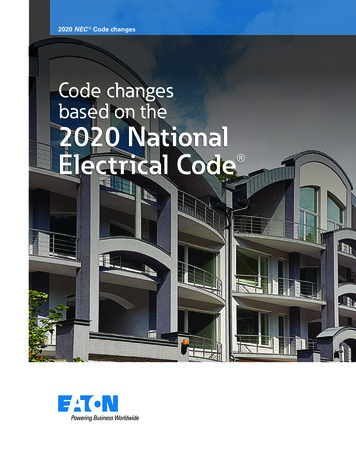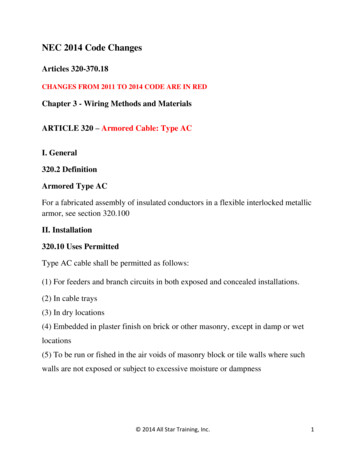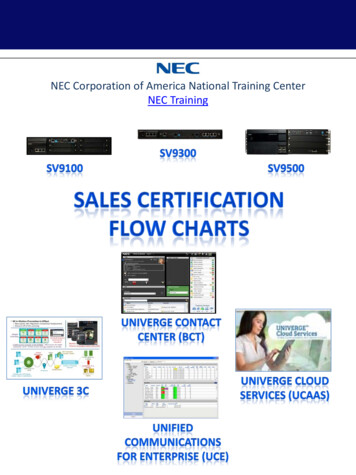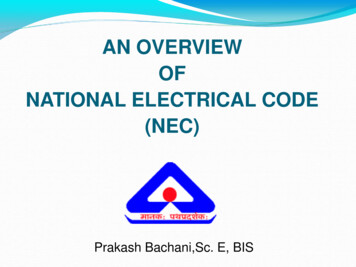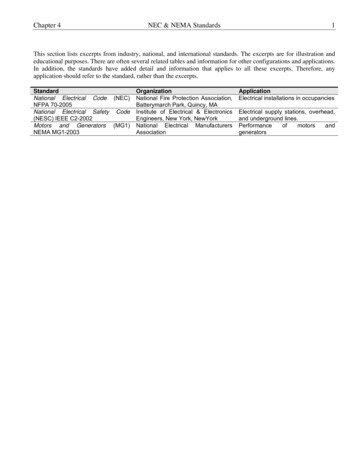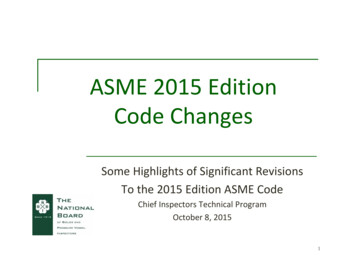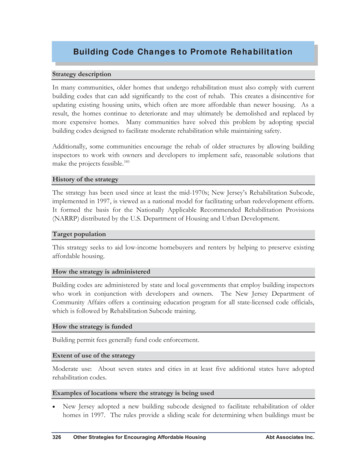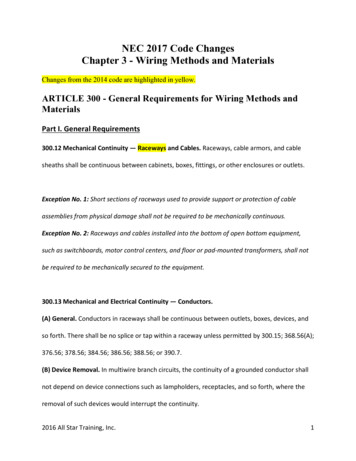
Transcription
NEC 2017 Code ChangesChapter 3 - Wiring Methods and MaterialsChanges from the 2014 code are highlighted in yellow.ARTICLE 300 - General Requirements for Wiring Methods andMaterialsPart I. General Requirements300.12 Mechanical Continuity — Raceways and Cables. Raceways, cable armors, and cablesheaths shall be continuous between cabinets, boxes, fittings, or other enclosures or outlets.Exception No. 1: Short sections of raceways used to provide support or protection of cableassemblies from physical damage shall not be required to be mechanically continuous.Exception No. 2: Raceways and cables installed into the bottom of open bottom equipment,such as switchboards, motor control centers, and floor or pad-mounted transformers, shall notbe required to be mechanically secured to the equipment.300.13 Mechanical and Electrical Continuity — Conductors.(A) General. Conductors in raceways shall be continuous between outlets, boxes, devices, andso forth. There shall be no splice or tap within a raceway unless permitted by 300.15; 368.56(A);376.56; 378.56; 384.56; 386.56; 388.56; or 390.7.(B) Device Removal. In multiwire branch circuits, the continuity of a grounded conductor shallnot depend on device connections such as lampholders, receptacles, and so forth, where theremoval of such devices would interrupt the continuity.2016 All Star Training, Inc.1
300.14 Length of Free Conductors at Outlets, Junctions, and Switch Points. At least 150 mm (6in.) of free conductor, measured from the point in the box where it emerges from its racewayor cable sheath, shall be left at each outlet, junction, and switch point for splices or theconnection of luminaires or devices. Where the opening to an outlet, junction, or switchpoint is less than 200 mm (8 in.) in any dimension, each conductor shall be long enough toextend at least 75 mm (3 in.) outside the opening.Exception: Conductors that are not spliced or terminated at the outlet, junction, or switch pointshall not be required to comply with 300.14.300.15 Boxes, Conduit Bodies, or Fittings — Where Required. A box shall be installed at eachoutlet and switch point for concealed knob-and-tube wiring. Fittings and connectors shall beused only with the specific wiring methods for which they are designed and listed. Where thewiring method is conduit, tubing, Type AC cable, Type MC cable, Type MI cable, nonmetallicsheathed cable, or other cables, a box or conduit body shall be installed at each conductorsplice point, outlet point, switch point, junction point, termination point, or pull point, unlessotherwise permitted in 300.15(A) through (L).(A) Wiring Methods with Interior Access. A box or conduit body shall not be required for eachsplice, junction, switch, pull, termination, or outlet points in wiring methods withremovable covers, such as wireways, multioutlet assemblies, auxiliary gutters, and surfaceraceways. The covers shall be accessible after installation.2016 All Star Training, Inc.2
(B) Equipment. An integral junction box or wiring compartment as part of approved equipmentshall be permitted in lieu of a box.(C) Protection. A box or conduit body shall not be required where cables enter or exit fromconduit or tubing that is used to provide cable support or protection against physical damage.A fitting shall be provided on the end(s) of the conduit or tubing to protect the cable fromabrasion.(D) Type MI Cable. A box or conduit body shall not be required where accessible fittings areused for straight-through splices in mineral-insulated metal-sheathed cable.(E) Integral Enclosure. A wiring device with integral enclosure identified for the use, havingbrackets that securely fasten the device to walls or ceilings of conventional on-site frameconstruction, for use with nonmetallic-sheathed cable, shall be permitted in lieu of a box orconduit body.Informational Note: See 334.30(C); 545.10; 550.15(I); 551.47(E), Exception No. 1; and552.48(E), Exception No. 1.(F) Fitting. A fitting identified for the use shall be permitted in lieu of a box or conduit bodywhere conductors are not spliced or terminated within the fitting. The fitting shall beaccessible after installation.(G) Direct-Buried Conductors. As permitted in 300.5(E), a box or conduit body shall not berequired for splices and taps in direct-buried conductors and cables.2016 All Star Training, Inc.3
(H) Insulated Devices. As permitted in 334.40(B), a box or conduit body shall not be requiredfor insulated devices supplied by nonmetallic-sheathed cable.(I) Enclosures. A box or conduit body shall not be required where a splice, switch, terminal, orpull point is in a cabinet or cutout box, in an enclosure for a switch or overcurrent deviceas permitted in 312.8, in a motor controller as permitted in 430.10(A), or in a motor controlcenter.(J) Luminaires. A box or conduit body shall not be required where a luminaire is used as araceway as permitted in 410.64.(K) Embedded. A box or conduit body shall not be required for splices where conductors areembedded as permitted in 424.40, 424.41(D), 426.22(B), 426.24(A), and 427.19(A).(L) Manholes and Handhole Enclosures. A box or conduit body shall not be required forconductors in manholes or handhole enclosures, except where connecting to electricalequipment. The installation shall comply with the provisions of Part V of Article 110 formanholes, and 314.30 for handhole enclosures.300.16 Raceway or Cable to Open or Concealed Wiring.(A) Box, Conduit Body, or Fitting. A box, conduit body, or terminal fitting having a separatelybushed hole for each conductor shall be used wherever a change is made from conduit,electrical metallic tubing, electrical nonmetallic tubing, nonmetallic-sheathed cable, Type ACcable, Type MC cable, or mineral-insulated, metal-sheathed cable and surface raceway wiringto open wiring or to concealed knob-and-tube wiring. A fitting used for this purpose shallcontain no taps or splices and shall not be used at luminaire outlets. A conduit body used forthis purpose shall contain no taps or splices, unless it complies with 314.16(C)(2).2016 All Star Training, Inc.4
(B) Bushing. A bushing shall be permitted in lieu of a box or terminal where the conductorsemerge from a raceway and enter or terminate at equipment, such as open switchboards,unenclosed control equipment, or similar equipment. The bushing shall be of the insulatingtype for other than leadsheathed conductors.300.17 Number and Size of Conductors in Raceway. The number and size of conductors in anyraceway shall not be more than will permit dissipation of the heat and ready installationor withdrawal of the conductors without damage to the conductors or to their insulation.Informational Note: See the following sections of this Code: intermediate metal conduit,342.22; rigid metal conduit, 344.22; flexible metal conduit, 348.22; liquidtight flexible metalconduit, 350.22; PVC conduit, 352.22; HDPE conduit, 353.22; RTRC, 355.22; liquidtightnonmetallic flexible conduit, 356.22; electrical metallic tubing, 358.22; flexible metallic tubing,360.22; electrical nonmetallic tubing, 362.22; cellular concrete floor raceways, 372.22; cellularmetal floor raceways, 374.22; metal wireways, 376.22; nonmetallic wireways, 378.22; surfacemetal raceways, 386.22; surface nonmetallic raceways, 388.22; underfloor raceways, 390.6;fixture wire, 402.7; theaters, 520.6; signs, 600.31(C); elevators, 620.33; audio signal processing,amplification, and reproduction equipment, 640.23(A) and 640.24; Class 1, Class 2, and Class 3circuits, Article 725; fire alarm circuits, Article 760; and optical fiber cables and raceways, Article770.2016 All Star Training, Inc.5
300.18 Raceway Installations.(A) Complete Runs. Raceways, other than busways or exposed raceways having hinged orremovable covers, shall be installed complete between outlet, junction, or splicing points priorto the installation of conductors. Where required to facilitate the installation of utilizationequipment, the raceway shall be permitted to be initially installed without a terminatingconnection at the equipment. Prewired raceway assemblies shall be permitted only wherespecifically permitted in this Code for the applicable wiring method.Exception: Short sections of raceways used to contain conductors or cable assemblies forprotection from physical damage shall not be required to be installed complete between outlet,junction, or splicing points.(B) Welding. Metal raceways shall not be supported, terminated, or connected by welding tothe raceway unless specifically designed to be or otherwise specifically permitted to be in thisCode.300.19 Supporting Conductors in Vertical Raceways.(A) Spacing Intervals — Maximum. Conductors in vertical raceways shall be supported if thevertical rise exceeds the values in Table 300.19(A). At least one support method shall beprovided for each conductor at the top of the vertical raceway or as close to the top aspractical. Intermediate supports shall be provided as necessary to limit supported conductorlengths to not greater than those values specified in Table 300.19(A).2016 All Star Training, Inc.6
Exception: Steel wire armor cable shall be supported at the top of the riser with a cable supportthat clamps the steel wire armor. A safety device shall be permitted at the lower end of the riserto hold the cable in the event there is slippage of the cable in the wire-armored cable support.Additional wedge-type supports shall be permitted to relieve the strain on the equipmentterminals caused by expansion of the cable under load.(B) Fire-Rated Cables and Conductors. Support methods and spacing intervals for fire-ratedcables and conductors shall comply with any restrictions provided in the listing of the electricalcircuit protective system used and in no case shall exceed the values in Table 300.19(A).(C) Support Methods. One of the following methods of support shall be used:(1) By clamping devices constructed of or employing insulating wedges inserted in theends of the raceways. Where clamping of insulation does not adequately support thecable, the conductor also shall be clamped.2016 All Star Training, Inc.7
(2) By inserting boxes at the required intervals in which insulating supports are installedand secured in an approved manner to withstand the weight of the conductors attachedthereto, the boxes being provided with covers.(3) In junction boxes, by deflecting the cables not less than 90 degrees and carryingthem horizontally to a distance not less than twice the diameter of the cable, the cablesbeing carried on two or more insulating supports and additionally secured thereto by tiewires if desired. Where this method is used, cables shall be supported at intervals notgreater than 20 percent of those mentioned in the preceding tabulation.(4) By other approved means.300.20 Induced Currents in Ferrous Metal Enclosures or Ferrous Metal Raceways.(A) Conductors Grouped Together. Where conductors carrying alternating current are installedin ferrous metal enclosures or ferrous metal raceways, they shall be arranged so as to avoidheating the surrounding ferrous metal by induction. To accomplish this, all phase conductorsand, where used, the grounded conductor and all equipment grounding conductors shall begrouped together.Exception No. 1: Equipment grounding conductors for certain existing installations shall bepermitted to be installed separate from their associated circuit conductors where run inaccordance with the provisions of 250.130(C).Exception No. 2: A single conductor shall be permitted to be installed in a ferromagneticenclosure and used for skin-effect heating in accordance with the provisions of 426.42 and427.47.2016 All Star Training, Inc.8
(B) Individual Conductors. Where a single conductor carrying alternating current passesthrough metal with magnetic properties, the inductive effect shall be minimized by(1) cutting slots in the metal between the individual holes through which the individualconductors pass or(2) passing all the conductors in the circuit through an insulating wall sufficiently largefor all of the conductors of the circuit.Exception: In the case of circuits supplying vacuum or electric-discharge lighting systems orsigns or X-ray apparatus, the currents carried by the conductors are so small that the inductiveheating effect can be ignored where these conductors are placed in metal enclosures or passthrough metal.Informational Note: Because aluminum is not a magnetic metal, there will be no heating due tohysteresis; however, induced currents will be present. They will not be of sufficient magnitudeto require grouping of conductors or special treatment in passing conductors throughaluminum wall sections.300.21 Spread of Fire or Products of Combustion. Electrical installations in hollow spaces,vertical shafts, and ventilation or air-handling ducts shall be made so that the possible spread offire or products of combustion will not be substantially increased. Openings around electricalpenetrations into or through fire-resistant-rated walls, partitions, floors, or ceilings shall befirestopped using approved methods to maintain the fire resistance rating.2016 All Star Training, Inc.9
Informational Note: Directories of electrical construction materials published by qualifiedtesting laboratories contain many listing installation restrictions necessary to maintain the fireresistive rating of assemblies where penetrations or openings are made. Building codes alsocontain restrictions on membrane penetrations on opposite sides of a fire-resistance-rated wallassembly. An example is the 600-mm (24-in.) minimum horizontal separation that usuallyapplies between boxes installed on opposite sides of the wall. Assistance in complying with300.21 can be found in building codes, fire resistance directories, and product listings.300.22 Wiring in Ducts Not Used for Air Handling, Fabricated Ducts for Environmental Air, andOther Spaces for Environmental Air (P
NEC 2017 Code Changes Chapter 3 - Wiring Methods and Materials Changes from the 2014 code are highlighted in yellow. ARTICLE 300 - General Requirements for Wiring Methods and Materials Part I. General Requirements 300.12 Mechanical Continuity — Raceways and Cables. Raceways, cable armors, and cable sheaths shall be continuous between cabinets, boxes, fittings, or other enclosures or outlets .
